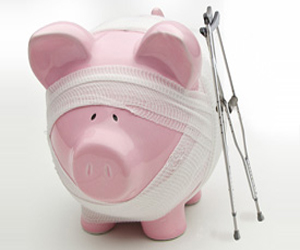Send this article to a friend:
May
07
2022

Send this article to a friend: May |
 |
The Fed’s “Soft Landing” Is Still a Crash… And Here’s Why
The Fed decided to raise rates only 50 basis points, and initiated plans to “significantly reduce the Federal Reserve’s securities holdings.” More rate hikes are on the way as 2022 continues, and starting June 1st, the QE tightening is likely to get even stronger:
In response to the recent announcements, on Thursday the Dow Jones tumbled almost 1,100 points. The NASDAQ also lost 5% of its value. Both losses completely erased their relief-rally gains from the day before – when stock bulls were excited the Fed didn’t raise rates higher. Their enthusiasm lasted less than 24 hours… So far, the S&P 500 is having its worst yearly start since 1939, down over 13%. April alone was the Nasdaq’s worst month since the 2008 financial crisis. Even a broad index of the U.S. bond market is off nearly 11%. What’s going on here? It’s a war. On one side, we have Wall Street firms and their partisans (day-trading stock bulls) who believe the Fed would never really let the stock market drop. On the other side, we have the Fed, who are trying to bring inflation back in line before the midterm elections – because inflation is a political issue now, it’s a priority for the Fed. However, the Fed has to pull off a very tricky balancing act. Federal Reserve Chair Jerome Powell needs to execute the economic equivalent of landing a Boeing 737 with no engines. If he goes too fast, he’ll overshoot the runway. If he goes too slow, the plane will come down in a forest. A little too far to left or right lie disaster. In this scenario, there’s exactly one path that leads to a soft landing – to the passengers walking away from the plane. And there are nearly an infinite number of ways to crash the plane instead… So can Powell bring the U.S. economy back from the brink of disaster? Can they achieve the proverbial “soft landing,” avoiding overshooting into a stagflationary “lost decade” and undershooting, kicking off years of double-digit inflation? That’s where things get really interesting… Experts chime in on the Fed’s response: “All a show” Powell’s Fed certainly have their work cut out for them. If they had a reliable copilot, the future would look a little more hopeful. If the Fed and the Biden administration worked hand-in-hand, to counter inflation and balance the budget, success would almost be guaranteed. Sadly, the Fed’s on its own. The Biden administration has a stubborn commitment to massive wasteful government projects, which they say will “lower debt” and are “anti-inflationary” and we’re hearing this from Pelosi, Biden, from everyone. And some economists seem to agree… According to Wall Street strategist Solomon Tadesse, who predicted the rate craziness back in February-March of 2020, the Fed can only hike rates about 1% before it has to back off. The Federal Funds Rate is almost there now. Even Agora’s normally mild-mannered Bill Bonner is calling the Fed’s latest rate-hike and threat to tighten its balance sheet “guiding the plane right into the ground.” Here’s why:
That’s where the “Taylor Rule” comes in, which according to Investopedia: “[…] has been interpreted both as a way to forecast Fed monetary policy and as a fixed rule policy to guide monetary policy in response to changes in economic conditions.” Right now, the Taylor Rule says the Fed is far, far off-base on interest rates to the tune of 1,165 basis points. You can see the latest official Fed estimate reflected on the chart here. That would take rates over 12% — which would be impossible when the markets are already nose-diving over a mere 50 basis point hike. Just half a percent interest rate increase is already the biggest hike in two decades. The truth is, markets (stock and housing alike) have grown addicted to the Fed’s easy-money policies. That’s why even barely nudging interest rates higher has such a dramatic effect on asset prices. Analyst Larry MacDonald doesn’t think it would make any difference what the Fed does, and that a recession is likely to be incoming full-speed:
But no matter what actually happens over the next year, the outcome doesn’t look good. Looking back to the time when Powell was calling inflation “transitory” and blaming him won’t help us that much, either. What may actually help is to brace ourselves for the nearly-inevitable impact. Something more useful than back-seat piloting During times like these, when uncertainty is the only certainty, what we really need is peace of mind. That way, we can turn off the mainstream media and stop analyzing and worrying about Powell’s future announcements after the next FOMC meetings. Financial peace of mind is hard to find these days. That’s why we think now is the time to evaluate your plans and ensure your savings, and your sanity, are protected for the next catastrophe. Making your savings more resilient (and possibly even more profitable) despite future inflationary periods and bear markets can help you sleep peacefully through the night. Even after a brutal day in the stock market. That means now is a good time to take a few minutes and learn about diversifying your savings with physical gold and silver. It’s likely the diversification benefits of physical precious metals, the security of knowing some assets will always be worth owning, can help you protect yourself and your family’s financial future.
|
Send this article to a friend:
 |
 |
 |